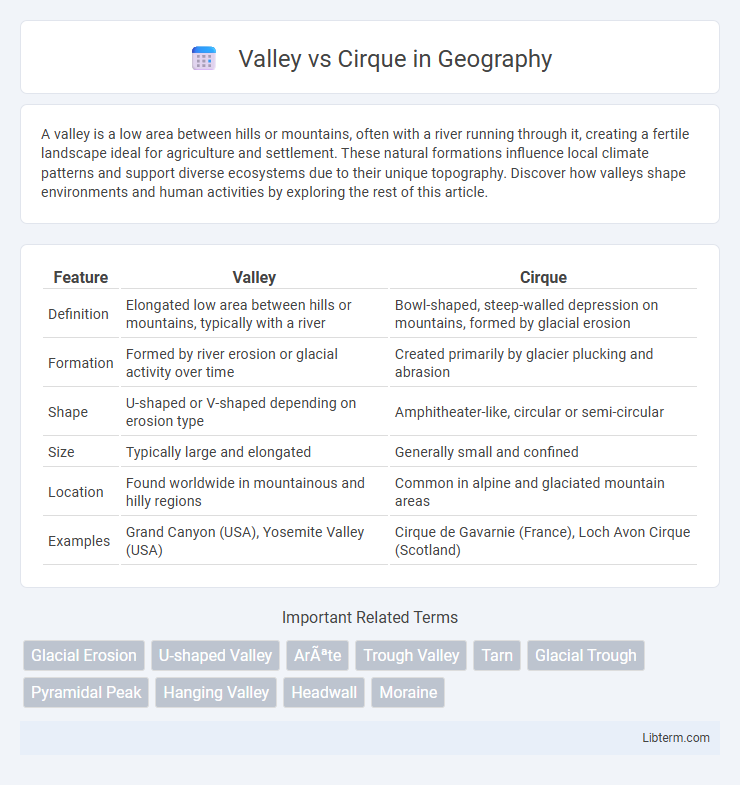A valley is a low area between hills or mountains, often with a river running through it, creating a fertile landscape ideal for agriculture and settlement. These natural formations influence local climate patterns and support diverse ecosystems due to their unique topography. Discover how valleys shape environments and human activities by exploring the rest of this article.
Table of Comparison
| Feature | Valley | Cirque |
|---|---|---|
| Definition | Elongated low area between hills or mountains, typically with a river | Bowl-shaped, steep-walled depression on mountains, formed by glacial erosion |
| Formation | Formed by river erosion or glacial activity over time | Created primarily by glacier plucking and abrasion |
| Shape | U-shaped or V-shaped depending on erosion type | Amphitheater-like, circular or semi-circular |
| Size | Typically large and elongated | Generally small and confined |
| Location | Found worldwide in mountainous and hilly regions | Common in alpine and glaciated mountain areas |
| Examples | Grand Canyon (USA), Yosemite Valley (USA) | Cirque de Gavarnie (France), Loch Avon Cirque (Scotland) |
Understanding Valleys and Cirques
Valleys are elongated depressions in the landscape typically formed by river erosion or glacial activity, characterized by their V-shaped or U-shaped profiles depending on the dominant erosional process. Cirques are amphitheater-like hollows found at the head of glacial valleys, formed by the accumulation and rotational movement of glacier ice, often marked by steep headwalls and a bowl-shaped floor. Understanding the distinctive geomorphological features of valleys and cirques aids in interpreting past and present glacial dynamics and landscape evolution.
Geological Formation of Valleys
Valleys form primarily through the erosional action of rivers and glaciers cutting into the Earth's surface, creating elongated depressions between hills or mountains. River valleys typically exhibit a V-shaped profile due to vertical erosion, while glacial valleys are U-shaped, carved by the movement of ice masses. The geological formation of valleys depends on factors such as rock type, climate, tectonic activity, and erosion processes influencing their shape and depth.
Geological Formation of Cirques
Cirques are amphitheater-like hollows formed by glacial erosion, typically found at the head of a valley glacier, where cirque glaciers carve out steep-walled, bowl-shaped depressions. The geological formation of cirques involves processes such as plucking and abrasion, where freeze-thaw weathering causes rock detachment and glacial movement scours the bedrock. These features distinguish cirques from valleys, which are primarily formed by river erosion or extensive glacial carving creating elongated troughs.
Key Differences Between Valleys and Cirques
Valleys are elongated depressions formed primarily by river erosion or glacial activity, often featuring gentle slopes and extending over large areas, whereas cirques are amphitheater-like hollow formations carved by glacial ice at the heads of valleys. Valleys typically have V-shaped or U-shaped cross-sections, contrasting with the steep, bowl-shaped morphology of cirques. The scale also differs significantly, with valleys spanning several kilometers and cirques usually limited to hundreds of meters in diameter.
Types of Valleys
Valleys are primarily classified into river valleys, glacial valleys, and rift valleys, each formed by distinct geological processes. River valleys, typically V-shaped, result from erosional activities of flowing water, while cirques are amphitheater-like hollow forms created by glacial erosion at the head of a glacier. Unlike cirques, which are specific glacial features, valley types encompass broader landforms shaped by multiple erosional and tectonic forces.
Types of Cirques
Cirques, also known as corries or cwms, are amphitheater-shaped depressions formed by glacial erosion, differing significantly from valleys which are elongated landforms. Types of cirques include tectonic cirques formed by faulting, glacial cirques carved by ice accumulation and movement, and composite cirques shaped by a combination of glacial and tectonic processes. These cirques vary in size, steepness, and morphology, influencing the surrounding landscape's hydrology and vegetation patterns.
Erosion Processes in Valleys vs Cirques
Valleys primarily form through fluvial erosion where rivers cut downward into bedrock, creating V-shaped profiles, whereas cirques develop via glacial erosion, characterized by plucking and abrasion at the head of glaciers, producing bowl-shaped, steep-walled depressions. The key erosion processes in valleys include hydraulic action and sediment transport, intensifying vertical incision, while cirques experience freeze-thaw weathering and rotational sliding that amplify glacial sculpting. Over time, valley erosion results in extensive drainage networks, contrasting with localized, deep excavation typical of cirque formation.
Examples of Valleys Worldwide
The Grand Canyon in the United States exemplifies a vast and deep valley carved by the Colorado River, showcasing the power of erosion over millions of years. The Rhine Valley in Germany demonstrates a scenic river valley rich in vineyards, castles, and historic towns, attracting millions of tourists annually. The Kathmandu Valley in Nepal is a tectonic valley known for its cultural heritage and dense population, contrasting with the typically natural and sparse cirques found in high mountain regions like the Alps.
Famous Cirques Around the Globe
Famous cirques like Cirque de Gavarnie in the French Pyrenees and Cirque Glacier in Banff National Park showcase the dramatic amphitheater-shaped hollows formed by glacial erosion. Unlike valleys, which are elongated depressions carved by rivers or glaciers, cirques are bowl-shaped and typically found at the head of glacial valleys. These iconic cirques are renowned for their steep cliffs, cascading waterfalls, and stunning natural landscapes, attracting hikers and geologists worldwide.
Ecological and Climatic Impact of Valleys and Cirques
Valleys, formed by river erosion or glacial activity, play a crucial role in biodiversity by creating diverse habitats that support varied flora and fauna, while also facilitating natural water drainage and nutrient cycling. Cirques, bowl-shaped depressions carved by glacial erosion, influence local microclimates by trapping cold air and snow, which helps sustain alpine ecosystems sensitive to temperature fluctuations. Both landforms significantly affect regional climate patterns and ecological dynamics, with valleys often acting as corridors for species migration and cirques serving as refuges for cold-adapted species.
Valley Infographic

 libterm.com
libterm.com